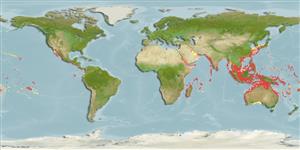Common names from other countries
Environment: milieu / climate zone / depth range / distribution range
Sinh thái học
; Mức độ sâu 20 - 80 m (Ref. 93550). Tropical
Indo-Pacific: from East Africa to Melanesia and Easter Island.
Length at first maturity / Bộ gần gũi / Khối lượng (Trọng lượng) / Age
Maturity: Lm ? range ? - ? cm Max length : 10.0 cm SHL con đực/không giới tính; (Ref. 348); common length : 7.0 cm SHL con đực/không giới tính; (Ref. 348)
Minimum depth from Ref. 106682. Collected for food in some areas. Shell used as raw material to make lime and for shellcraft (Ref. 348). Found in reef areas of lagoons (Ref. 97298); from immediate subtidal to 20 m; attached to rock (Ref. 337). Strongly cemented to rock or coral platforms. At low tide levels and shallow subtidal depths (Ref. 348).
Life cycle and mating behavior
Chín muồi sinh dục | Sự tái sinh sản | Đẻ trứng | Các trứng | Sự sinh sản | Ấu trùng
Members of the class Bivalvia are mostly gonochoric, some are protandric hermaphrodites. Life cycle: Embryos develop into free-swimming trocophore larvae, succeeded by the bivalve veliger, resembling a miniature clam.
Raines, B. and M. Huber. 2012. (Ref. 93550)
IUCN Red List Status (Ref. 130435)
CITES status (Ref. 108899)
Not Evaluated
Not Evaluated
Threat to humans
Harmless
Human uses
Các nghề cá: Tính thương mại
| FishSource |
Các công cụ
Thêm thông tin
Age/SizeSự sinh trưởngLength-weightLength-lengthHình thái họcẤu trùngSự phong phú
Các nguồn internet
Estimates based on models
Preferred temperature
(Ref.
115969): 20.4 - 28.4, mean 27.3 (based on 515 cells).
Vulnerability
Low vulnerability (10 of 100).
Price category
Unknown.
